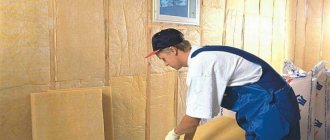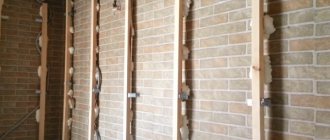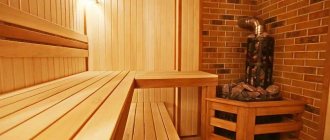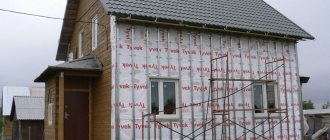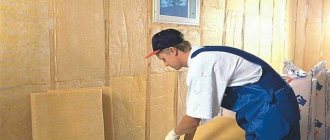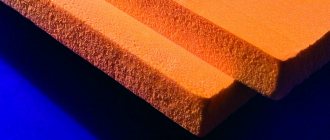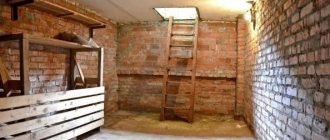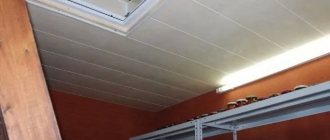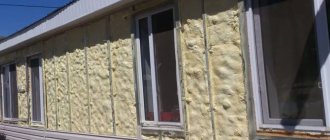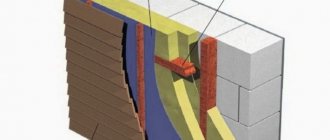- From timber
When setting up a steam room, it is very important to take care of the quality of its thermal insulation. Therefore, today we will tell you how to insulate walls in a bathhouse from the inside. Let's consider what materials to choose depending on the nature of the structure, what technology is used to lay them and the rules followed. Let us immediately note that it is ineffective to carry out such work outside the building, no matter what it is made of, timber, concrete or brick.
Advantages of internal insulation
- Reduces fuel consumption (either solid fuel, such as wood or coal, or gas) and reduces heating time.
- It is the key to the desired microclimate in the steam room. You will forget about drafts, dampness, cold, and you will be able to feel comfortable in any season.
- Ensures proper circulation of hot air, preventing condensed moisture from settling on various surfaces of the rooms. Thanks to this, the cladding remains dry, resists mold and fungi, does not rot, does not deteriorate longer and looks beautiful in a new way.
Expanded clay
Fine bulk material in the form of clayey porous stones. The manufacturing technology involves high-temperature firing of clay. Expanded clay granules can have different sizes, which affects the thermal insulation properties of the material. For a bath, it is better to use filler with smaller fractions.
Can be used as ceiling or floor insulation in a bathhouse. When insulating the ceiling, the layer of expanded clay will be 20-30 cm, which, for example, is justified if there is no attic in the bathhouse.
Let us note the main advantages of expanded clay:
- The product is environmentally friendly. Without toxic impurities.
- The low thermal conductivity of the material explains the high energy efficiency of thermal insulation.
- Frost-resistant material, able to withstand regular heating and cooling cycles.
- Does not attract mice and other rodents.
- Biologically resistant to mold and fungal colonies.
- The fire resistance of the material allows it to be used in potentially fire hazardous areas.
- Cheapness.
Serious disadvantages include:
- Fragility of expanded clay granules. Working with it is not as easy as it might seem at first glance. Damaged material granules lose their thermal insulation properties.
- High water absorption due to the porous structure of the fractions dictates the mandatory use of high-quality waterproofing.
Which insulation is better depending on the type of building
When choosing insulation for the walls of a bathhouse, it is important to consider what material it is built from.
From timber
In the case of a durable type of wood and a relatively large cross-section of each element of the frame, it is enough to simply caulk the cracks and treat the walls with impregnations against fungus and mold, as well as compounds that protect against moisture and fire.
In other situations, all rooms (especially the steam room) must be insulated with basalt wool - in one layer, using the “Pie” technology (we will consider it separately below), additionally laying foil material to minimize the harmful effects of steam.
Made of brick
It freezes quickly in the cold season. This means that measures need to be taken to ensure that a suitable microclimate inside is maintained even in the harshest winter. To do this you can:
- install second walls around the entire perimeter;
- or make a double thermal insulation layer.
To create the sheathing, it is better to use wood rather than metal, since the latter gets very hot during operation. Naturally, it is recommended to treat the prepared structure with agents against fire, rotting, and insects.
Made from concrete
In this case, you can insulate the walls in the steam room of the bathhouse from the inside and outside. Such a serious approach will result in the absence of problems with the masonry getting wet (due to condensed steam), and will become a measure that effectively prevents rapid destruction.
Here the craftsman upholsters the surfaces in the room with 10 cm thick mineral wool (or an analogue suitable in structure), and from the street he arranges a hinged ventilated facade, that is, he fixes the same basalt sheets and covers them with clapboard or siding. The method is relatively expensive, but it guarantees the correct microclimate.
Made from expanded clay concrete blocks
Here you will also need moisture-resistant material, but in combination with high-quality hydro- and vapor barrier. Plus, it is worth installing additional ventilation - this will help level out the increased level of humidity. It is quite acceptable to lay foil tape in as thin a layer as possible.
Vapor barrier properties
LOGICPIR insulation is laminated with vapor-proof foil - this eliminates the need for a separate vapor barrier layer. This will be confirmed by all professionals who know that only aluminum foil can be considered a full-fledged heat-resistant vapor barrier.
When gluing the joints of the plates with foil tape, a continuous and sealed vapor-tight layer is obtained, which reliably protects the entire structure from moisture. The foil does not allow moisture to pass through and reflects heat, like a mirror: it returns up to 95% of the energy of infrared rays from the sauna stove into the room.
Thanks to this, the bathhouse heats up faster, and the insulation layer becomes a reliable barrier between air with high and low temperatures. LOGICPIR retains heat in the room, like a warm fur coat.
How to properly insulate the walls of a bathhouse from the inside
First, let's talk about the general principles. According to them, the greatest attention should be paid to the key rooms - the steam room and the wash room. All calculations - the quantity and volume of components - should be carried out with a reserve, that is, taking into account rough consumption. It is better to immediately refuse cheap impregnations, compositions, solutions - this is the case when it is better to spend money, but make a decision for the long term, because if repairs are needed soon, you will overpay much more than you saved.
When choosing a material, you need to choose one that has the following characteristics:
- non-toxic and environmentally friendly;
- low hygroscopicity;
- resistance to high temperatures and steam;
- the ability to maintain shape for a long time and restore it after physical stress;
- fire-fighting properties.
"TechnoNIKOL"
Insulation for baths "TechnoNIKOL". Russian mineral wool goes on sale in a wide range. In private construction, three lines are used: “Rocklight”, “Technoblock”, “Technoacoustic”. All three types are suitable for both internal insulation, performed by specialists or with your own hands (using a vapor barrier), and for external work under siding.
Of all the types of fire-resistant wool produced by this manufacturer, TechnoNIKOL stitched mats (basalt insulation for baths), which do not contain phenols, are best suited for . In the manufacture of other types of products (TECHNO 03B, 03D, 03M boards), a low-phenolic binder is used.
“Pie” insulation technology
It is called so because, upon completion of the work, the wall is covered with several layers at once: thermal insulation, vapor barrier, cladding. You should start from top to bottom.
First of all, attach the bars to the load-bearing surfaces - at a distance from each other 1 cm less than the width of the mineral wool. Having created the frame in this way, you mount basalt slabs on it by surprise - carefully, without crushing the edge, ensuring a tight fit. Do not forget that gaps are places where moisture accumulates and “cold bridges” form.
Cover the resulting structure with a vapor barrier, so that its foil side faces the inside of the room, and be sure to seal all joints and seams with special tape. Then you perform the sheathing - directly on the wood of the still protruding base, at a distance of 5-10 cm from the previous layer. This way you will create a buffer zone in which the condensate will drain without coming into contact with the lining and without subjecting it to rot. And to finish, close the “Pie” with the lining.
Why we recommend using LOGICPIR insulation
What is the best way to insulate walls in a bathhouse and steam room? We recommend LOGICPIR insulation. This is a polymer material with a porous internal structure, lined with aluminum foil on both sides. At high temperatures, catalysts and additives form closed cells filled with low thermal conductivity gas.
In addition, this rigid insulation is very easy to process, cut and install. At the same time, it does not generate dust, does not prick, and does not irritate the mucous membranes of the person doing the installation. And it performs two functions at once: insulation and vapor barrier.
Ceiling insulation
It is carried out from top to bottom: it is simply more convenient to carry out work in this way, because it is easier to descend systematically than to take on one surface, skip another, and then return to it. It is this order that makes it possible to ensure the same microclimate at every point of the building - there will be no hot or cold zones. True, for this it is necessary to lay the materials overlapping, so that later it is easier to fasten them together.
Craftsmen thermally insulate the ceiling according to the following scheme:
- cover its surface overlapping with roll materials of your choice;
- the bars are mounted, forming a frame;
- place foil on top, covering all connections;
- glue the joints with aluminum tape (several times), evaluate the tightness;
- carry out installation;
- lined with clapboard finished to look like wood.
To sum it up. Let's make the right choice!
When insulating a bathhouse, the most important thing is to choose the right insulation wisely, because the microclimate as a whole and the productivity of the entire insulation depend on the characteristics of the selected material. What is typical is that you can use several different insulation materials in one bath at once in order to achieve the desired effect.
Note! The rating of materials and other information presented in the article are purely subjective; this is not a buying guide, much less an advertisement! Therefore, before choosing this or that insulation, it is advisable to consult with a good specialist.
Floor insulation
The technology is the same, regardless of the coating, concrete or wood. The only difference is the thickness of the pillow. And to control the evenness of the backfill, it is worth first applying markings to the base, conditionally dividing it into meter-long sections. If you plan to isolate the soil right away, then first compact it, cover the supporting surfaces around it with impregnations to protect it from moisture, sprinkle it with a layer of sand (10 cm), fill it with water, cover it with an overlap with roofing material and secure it with tape.
The order of the main work carried out by specialists is as follows:
- laying a vapor barrier film on the base, stretching it so that the edges along the walls are higher than the floor;
- installation of plasterboard profiles or other suitable guides and securing them with screws;
- placement of beacons at the required height in order to further control the level of the pillow;
- pouring expanded clay and leveling it using a slats or rake;
- arrangement of reinforcing mesh, filling it with concrete screed;
- laying the finishing layer.
You also need to know how and with what to insulate the walls of a bathhouse from the inside, not only in the steam room, but also in other rooms. The materials are the same, the general scheme of the wizard’s actions is as follows:
- waterproofing;
- placement of mineral wool;
- vapor barrier;
- finishing the resulting structure with clapboard.
This sequence of work is suitable for a dressing room, rest room and any other room that will not be used in conditions of high humidity and temperature.
To conclude, here are a few useful videos on the topic.
Insulation materials used
Of course, now straw is no longer used to insulate buildings. After all, it is an ineffective heat insulator compared to modern materials. Instead, they use insulation for the steam room, created in high-tech production. Manufacturers produce it in large quantities.
On a note! The thickness of the heat insulator for a steam room is not regulated. However, the approximate values of the material are indicated in SP 50.13330.2012. Experts advise using them as minimum values when calculating the required thickness of the heat insulator. It is recommended not to reduce the specified values in the rulebook.
Material thicknesses to ensure the necessary thermal insulation in accordance with current building codes in the Russian Federation Source diesel.elcat.kg
More often, foam plastic and mineral wool are used to reduce heat loss. After all, the heat-insulating layers of such materials will be the thinnest. The use of these heat insulators allows for effective heat conservation. However, do not forget about other thermal insulation materials.
The structures are insulated with non-flammable, non-toxic, moisture-resistant materials, which are also able to withstand the influence of heat for a long time. The process of thermal insulation is always given great attention. These works are carried out responsibly. Therefore, we use exclusively high-quality insulation for baths and saunas from trusted manufacturers.
Mineral wool based on basalt fiber
This type of insulation is a popular material option. Basalt fibers make it possible to create an environmentally friendly, non-toxic, non-flammable heat insulator that is not a source of release of harmful substances into the air.
Mineral wool has good resistance to water and steam. It is supplied in rolls. Manufacturers also make this material in the form of slabs, which are thicker.
Mineral wool in the form of slabs and rolls Source 1-teplodom.ru
The main advantages of mineral wool include:
- Use of non-toxic phenol during the production of basalt fiber material. Therefore, the heat insulator is the so-called stone wool, which is resistant to fire. It does not burn and prevents the spread of fire.
- Excellent noise absorption ability.
- Minimal shrinkage, since mineral wool does not increase in volume when in contact with water and does not dry out if exposed to high temperatures. Its shape remains unchanged throughout the entire period of use.
- Excellent hygroscopicity, which means the absence of the ability to absorb water.
Considering the disadvantages of mineral wool, experts note the ability to transmit steam. Because of this, to create an effective thermal insulation layer, it is necessary to additionally use a vapor barrier material.
Mineral wool is usually laid together with a vapor barrier material Source chudopol.ru
Mineral wool, like insulation in a bathhouse, is a relatively expensive heat insulator. In addition, craftsmen must always use protective equipment for hands, respiratory organs and eyes during installation. They usually protect all exposed areas of the body. Moreover, after completion of installation work, mineral wool will no longer pose any danger to humans.
See also: Catalog of companies that specialize in the design and construction of baths of any complexity
Expanded polystyrene or just polystyrene foam
This type of heat insulator is used to insulate floors between rooms and the attic of a bathhouse. It can even be used outside the building. With its help, the floors and walls of the structure are thermally insulated.
Thermal insulation of the ceiling with polystyrene foam Source eco-kotly.ru
Among all the advantages of expanded polystyrene, the following are its main advantages:
- excellent resistance to moisture;
- inability to maintain an open flame;
- little weight;
- low price;
- resistance to mold formation and proliferation of microorganisms;
- easy processing process.
Foam plastic, as insulation for a bathhouse, also has specific disadvantages. One of them is attractiveness to rodents. In particular, the material is eaten by mice. After this, the insulation properties of the insulation decrease.
In addition, the heat insulator releases toxic substances into the air if a fire occurs in the building. For this reason, polystyrene foam is not often installed in a steam room. After all, it is in such a room that a fire most often occurs in a bathhouse.
Polystyrene foam in a bathhouse is often installed in the dressing room, rest room Source pro-uteplenie.ru
On a note! Modern industry produces various finishing elements from polystyrene foam, which are widely used in the renovation of premises. These are moldings, baseboards and so on. They can often be found in modern baths.
Foil insulation material
Whatever insulation is used for the steam room in the bathhouse, it is also necessary to install a vapor barrier film. It is the laying of foil heat insulator that allows you to reduce the amount of work. After all, such material is both insulation and vapor barrier. In addition, a heat insulator with foil is still capable of reflecting thermal radiation, the source of which is a sauna stove. Thanks to its use, a thermos effect occurs inside the steam room.
Foil insulating material prevents heat from escaping from the room through various gaps in building structures. To make it, manufacturers use:
- foamed polyethylene;
- fibers from basalt rock;
- mineral raw materials;
- extruded polystyrene foam.
Extruded polystyrene foam with an additional foil coating Source espspb.ru
The foil coating of the heat insulator is made of aluminum or metallized lavsan. Insulation with foil usually does not burn well and can withstand significant temperatures.
Its disadvantage is the price, which is higher than other heat insulators that do not have reflective properties. In addition, it is easily damaged mechanically. Therefore, they try to carefully install such material, the shiny side of which is turned inside the steam room.
Penoplex insulating material
This type of insulation is extruded polystyrene foam. It is widely used as a heat insulator in the construction of various structures. After all, the material is a budget option for insulation. The technology for its production at modern enterprises is well developed. The production of such a heat insulator is carried out using high-tech equipment.
Manufacturers produce penoplex in the form of slabs. This type of extruded polystyrene foam is easy to cut, which allows for quick installation on any building structures of the bathhouse.
Insulating the floor of a bathhouse with penoplex Source centro-pol.ru
The advantages of penoplex include:
- ability to hold steam;
- low thermal conductivity;
- durability reaching 40 years;
- high compressive strength, since the heat insulator perfectly resists impact loads;
- affordable price compared to similar modern insulation materials.
Penoplex is thermal insulation for a bathhouse that burns well. In addition, it is a toxic material in case of fire. If damage appears on it, then the thermal insulator does not restore its original shape. It is also of interest to insects and rodents. Developers will not be able to purchase it cheaper than polystyrene foam.
Pros of mineral wool
This name refers to different types of insulation, including:
- glass wool;
- slag wool;
- mineral wool type isorock and others.
Mineral insulation for baths is considered the most economical
Glass wool is problematic to lay due to its caustic nature, although this material is not flammable and will not be eaten by rodents. The thermal conductivity of the material is at the level of the best samples - 0.038–0.046 W / (K*m). Slag wool also does not support combustion, but its thermal conductivity is ten times lower than that of glass wool (K = 0.46–0.48 W/(K*m). Isorock type mineral wool has similar characteristics.
Common advantages of different types of mineral wool:
- belong to the non-flammable class;
- unsuitable for the spread of rodents;
- have high thermal insulation properties.
The density of this material is in the range of 35–100 kg/m3.
Why is thermal insulation needed?
The bathhouse has many useful properties, but many of them may not be available if the internal insulation is not properly organized. In such a situation, even competently implemented construction work will not save you: if the walls of the building are not able to retain the heat created by the stove, the comfort of taking bath procedures will noticeably drop. The only way out is to reduce the time between kindlings, which, accordingly, will provoke an increase in financial costs for paying for energy resources.
A more correct solution is to insulate the bathhouse; fortunately, there are a number of effective technologies for this. It is best to do this during the construction of the building. However, if this important stage was missed for some reason, some methods of internal insulation can be implemented after construction is completed. The main difference between thermal insulation of a bathhouse and a similar procedure in an ordinary house is that in the first case, it is necessary to maintain the high temperature created by the stove for as long as possible inside the room. This requires a better approach to carrying out work.
Good thermal insulation means maximum energy efficiency for steam rooms and baths Source silpovoyage.ua
What is basalt wool
It has already been mentioned that basalt insulation belongs to the group of mineral materials. Its distinctive feature is the production raw materials used. To obtain the fibers of the future heat insulator, rock materials are used. Therefore, basalt wool is often called stone wool.
The production technology involves obtaining a liquid rock melt in a furnace at 1400-1500°C, from which fiber is drawn. Binding components are used to bind the resulting fibers into a homogeneous array. Correct selection of the binder base helps to significantly improve the characteristics of stone wool. After forming the structure, setting the direction of the layers and obtaining the required density, the finished material is cut to a standard size and packaged. Forms of release: mats, soft rolls, hard slabs.
